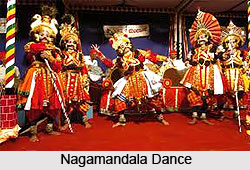 Nagamandala is a form of snake worship that is predominant in the coastal districts of Dakshina Kannada and Udupi. This traditional dance form is interesting to watch. The origin of Nagamandala is rooted in human curiosity. Snakes have always been a subject of awe and wonder in India. Their slithering movements and mystifying appearances are a matter of interest. Besides snakes are feared and revered as they are associated with Lord Shiva. Nagamandala, probably, originated in Karnataka from such beliefs.
Nagamandala is a form of snake worship that is predominant in the coastal districts of Dakshina Kannada and Udupi. This traditional dance form is interesting to watch. The origin of Nagamandala is rooted in human curiosity. Snakes have always been a subject of awe and wonder in India. Their slithering movements and mystifying appearances are a matter of interest. Besides snakes are feared and revered as they are associated with Lord Shiva. Nagamandala, probably, originated in Karnataka from such beliefs.
Nagamandala portrays the divine unification of male and female snakes. This is a long ritual where the performers are resplendently dressed. Traditionally it takes two people to perform this act. The ritual takes place at night and ends at dawn. The first priest or the Patri inhales the areca flower and enacts the male snake. The second priest or Nagakannika (female serpent) sings and dances around a detailed serpent design. This design is done with colors on the sacred ground. Five colors are used to draw this design - white mud, red, green, yellow, and black. All these colors are prepared from ingredients, such as, lime powder, turmeric powder, paddy husk, green leaves powder and others. A Dakke, an hourglass shaped musical instrument complements the dance.
Today Nagamandala is a more popular as an art form than a ritual. The remote villages of Karnataka still follow this tradition.



















